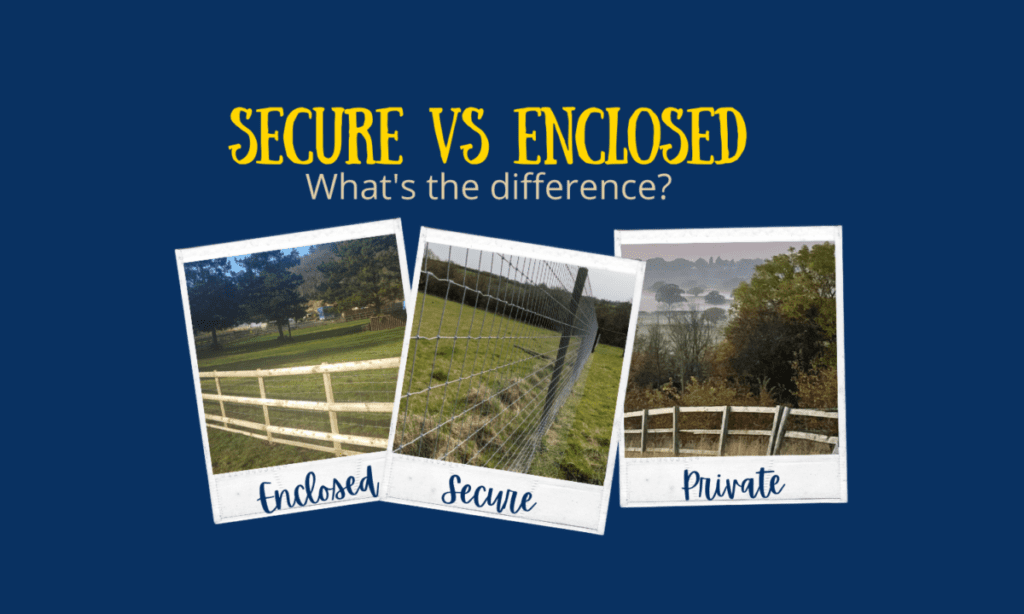If you’ve visited more than a handful of dog fields you will know that the words dog field owners use to describe them can vary in a way that can be confusing. This is because there is no industry standard that dictates what a dog field should be or should have by way of facilities. Here we’re going to explain what we mean when we describe a dog field as secure or enclosed to try and clarify things for you.
Enclosed Fields
Enclosed by a moderate fence – minimum 4ft stock fencing. They are suitable for non-reactive dogs with good recall.
Secure Fields
These dog walking fields are secure to at least 6ft (or 1.8m) all round and are considered safe for most dogs. These are the facilities that we recommend for reactive dogs and those that have strong prey drive or are prone to escape however it is important to note that there is no such thing as a fully secure dog field.
Using these descriptions, you might think it is pretty straight forward to determine whether something is enclosed or secure, or simply falls into another category we list – ‘private dog walking’. This is a small category of private parks and facilities that are available for hire but with no fences or, in most cases, the fences fall short of the minimum 4ft requirement and therefore offer little to no significant boundary.
On each of the verified fields listed on BritishDogFields.com, you will see close-up pictures of the fencing, often with a scale reference.

Here we’ll go into a little more detail about how we categorise dog field fencing, why some fields fall into a category you may not expect, and offer a bit more insight into how dog field fencing might be relevant to the breed, age and habits of your dog.
What is a Secure Dog Field?
We define a secure dog field as one that has fencing that is at least 6ft or 1.8m from the ground to the top of the fencing wire (not the post). The fencing has to be to this height all the way around the field, including gates to be included in the ‘secure’ category.
When you search here on the BritishDogFields.com using the fencing height filter, you will bring up all the fields that fall into that category, that also fit the other things you’re searching for – location, size etc. What it doesn’t tell you is what type of fencing that is and that’s why you need to review the fencing notes, and the field description if you are looking for a field that we have reviewed in person.

What Is An Enclosed Field?
These fields are often repurposed livestock fields but there are a number of field owners opting to install 4ft fencing to enclose their fields due to the enormous costs of installing 6ft or 5ft+ fencing compared with 4ft fencing which does not require the same specialist equipment and expertise.
These fields are perfectly suitable for many dogs but often have a more open mesh than secure field making it easy for smaller dogs and puppies to squeeze through the holes. Some fields will have rabbit mesh around the base to reduce any chance of escape.
You may also see a stock fence that is 2ft 6” with the addition of single stands of wire on top making the fence height up to 4ft and the same in fields with 5ft fencing, making it up to 6ft.
This is where some field owners descriptions of their fencing differs to ours in that we do not consider the addition of single strands of wire sufficient to classify a fence as enclosed when it is 2ft 6” plus 2 stands of wire or the same with 5ft plus strands. Why?! Because a single strand of wire leaves a very large gap between the fence posts and simply doesn’t offer the physical and visual deterrent that netting does.
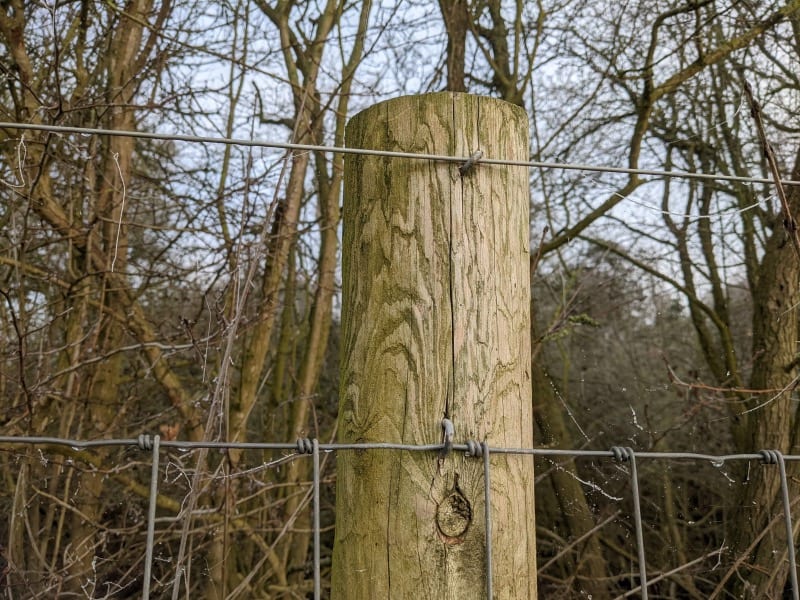
You may also see fields described as enclosed that are simply post and rail fences, with or without this shorter stock fencing. Again, these fields would be classified as private dog walking facilities because they are available for exclusive hire so you know you will be alone, but the fencing doesn’t offer the same level of security of a 4ft plus fenced facility.

We draw a line in the sand to make it easier for users of dog fields to understand what they are getting. It is generally considered that a 6ft fenced field will contain all but the most athletic dogs and owners of these animals are usually aware for their potential for escape.
In What Way Can the Fencing Be Different?
The fencing used to secure or enclose a dog field can vary hugely and here we’ll break down the elements that are most relevant to you when you are choosing a field to visit.
If you have a particular requirement, you must take note what a field owner calls the type of fencing they have. Here’s an example:
A great many people describe their fencing as deer fencing. The reality is that this doesn’t actually mean anything – different manufacturers all describe their fences differently and manufacture them to different specifications – see the example below – all marketed as Deer Fencing but considerably different in design and the level of security and containment they offer.


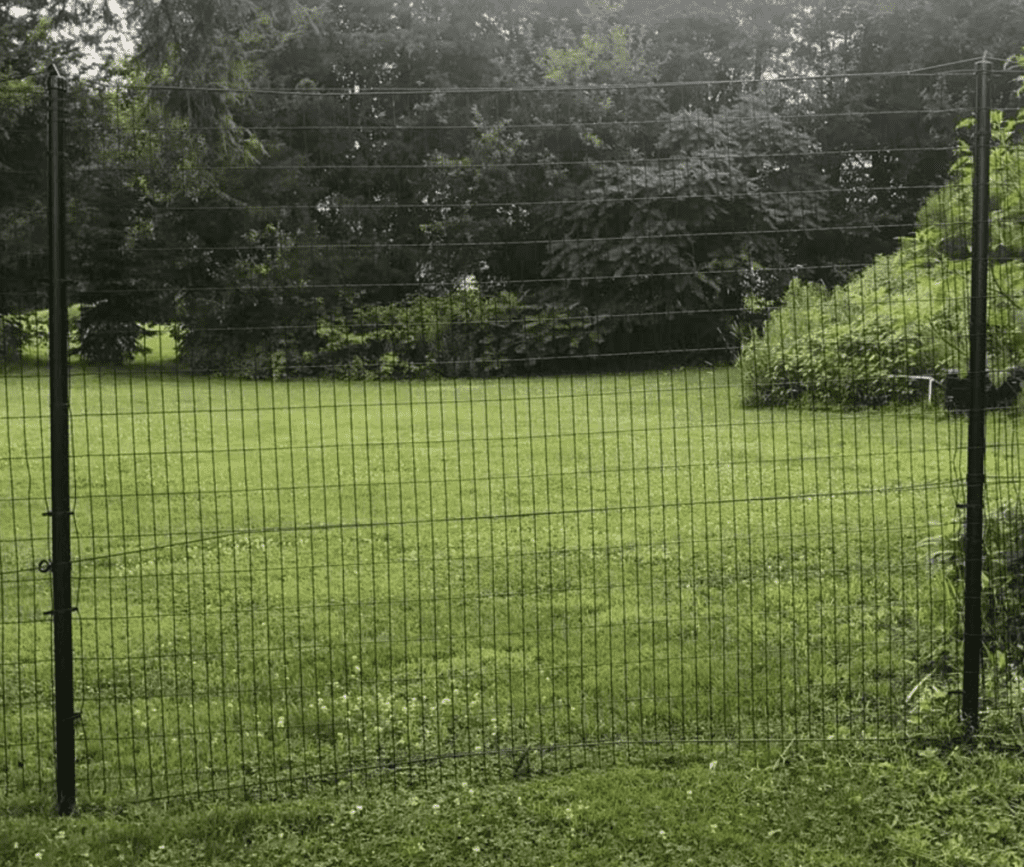
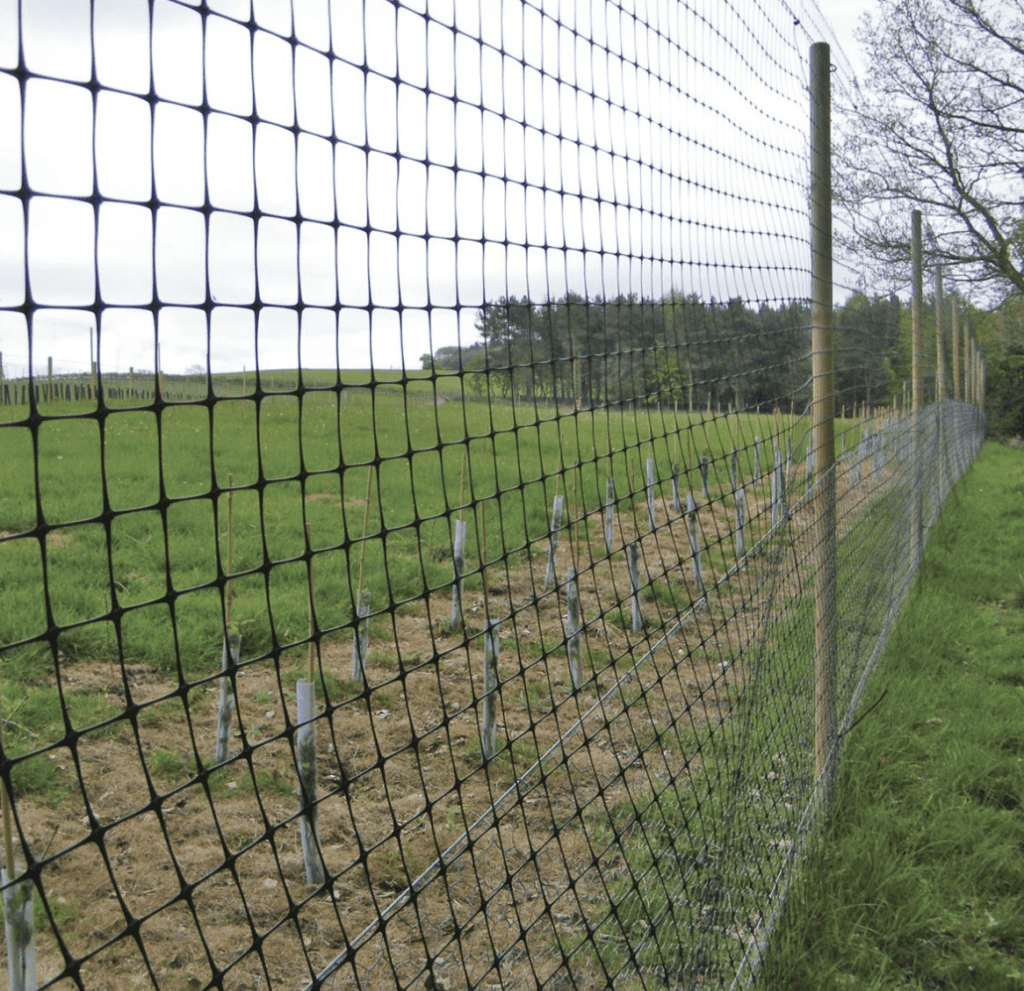

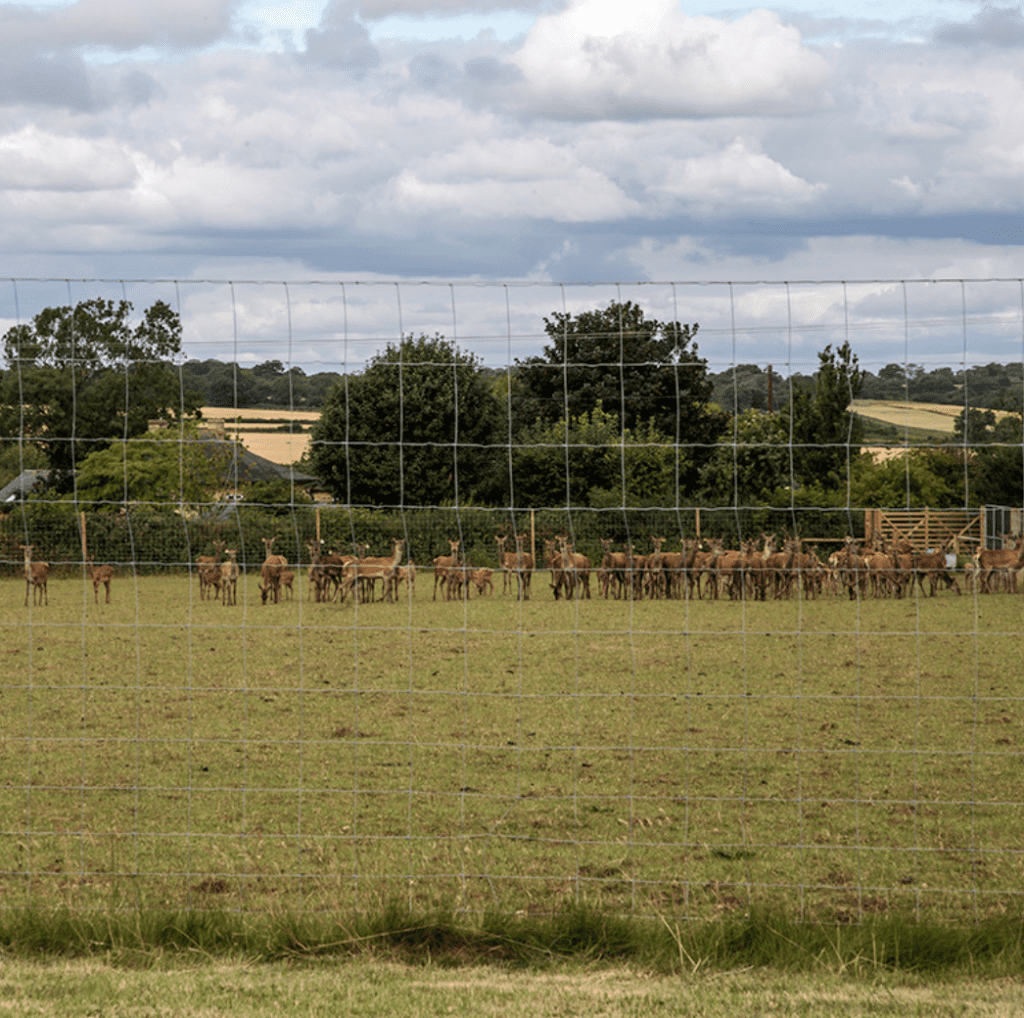
Aperture and gauge are the two elements that are most important to you as a dog field user.
Aperture – When we describe fencing as having a tight aperture, it means the size of the holes between the wires. Why is this important? If you have a toy, small breed, puppy, or take small children to a dog field, the size of those gaps are going to matter to you.
Some fences have an aperture that increases in size towards the top of the netting, making it less obtrusive visually. This is often used in dog fields where there has been a stipulation made by the planning authorities to make the fencing less prominent in the landscape.
The aperture can be more important in enclosed fields than in secure fields for some dog field users. Many people who are happy to use enclosed fields have smaller dogs that cannot jump a 4ft fence. However, they may well be able to squeeze out of standard stock fencing and therefore if you have small dogs and puppies, you may want to look for fields that have a smaller aperture fencing – sometimes this is described as horse or equine fencing. Here’s an example of that style of fencing.

There are also fields that choose to install very different style of fencing – feather board (like garden fencing), ridged welded mesh (like that you might see around school perimeters) or chain link fencing are just a few examples. A quick glance at photos of these fields will give you a good idea as these types of fencing tend to be more obvious and have the small holes that aren’t penetrable by any dog!
Gauge – This is the weight of the wire used in a net type fence which is what you will see in the vast majority of dog field fences. If you’re a fence geek, you’ll notice the difference! Next time you’re out for a walk, take a look at the stock fencing you see to enclose sheep pasture and you’ll see that it’s often a lot finer than the weight of the wire used in dog field fences.
There are a few fields that opt for a very heavy gauge wire. Visually these fences are a lot more obvious but some field owners choose this because it’s more durable if you have a customer base with large breeds that may lean on the fence or where livestock are present in adjacent fields.
Installation and Maintenance – Why This Is Important To You As A User
As you can probably already see, there’s a lot more to fencing that you might ever want to know! If you are a regular user of dog fields, you’ll also be aware that the installation and maintenance of a fence is also extremely important. Well-installed and maintained fields should:
- Not have wobbly posts or gates
- Be free from vegetation from the ground up – you should be able to see the fence is flush with, or well embedded in the ground – some fields choose to allow grass to knit at the bottom, connecting the fence to the land but this should be limited to not more than a foot or it is impossible to confirm the integrity of the fence – however our advice for all dog field owners is the keep the fence line completely clear to allow for thorough inspection
- Be under tension and not slack
- Have no exposed wire laid on the ground – some field owners lay a skirt of netting within the field with the intention of preventing digging. This should not be visible even in a newly opened field as dogs can catch their claws in the wire causing nasty injuries
- Have fence posts with a diameter that supports the weight of the netting
- Have posts that are sufficiently driven into the land to support the fence
- Have robust mechanisms for covering any holes that appear (pinned logs or planks for example)
- Have gates that are flush with the ground
What To Do If You Spot A Problem
If you visit a field where you think the fence has been compromised – perhaps where wildlife or dogs have dug at the fence-line, where a fence has become wobbly, where a gate posts has come loose (often someone unintentionally bumping it with a car), or where you think the gap under the gate is a cause for concern – you must let the field owner know. This should be a rare occurrence as all fields should be inspected daily but things happen.
Not all dog field owners have dogs, or understand reactive dogs. We’re all human and tend only to look through the lens of our own experience. You might go to a field that has large aperture 6ft fencing that you realise is unsuitable for your miniature dachshund that has a habit or testing fence boundaries, or visit a field that has 8ft fencing that looks as if it would keep in gorillas but only has a 4ft gate!
You should check the information supplied by the field owner before booking – don’t make any assumptions – the best field owners make it very clear what their facility is like so you can choose whether it suits you and your dog. However, if a field does not meet your expectations or indeed is misrepresented (not usually intentionally), dropping the owner a message to tell them about your experience (not publicly or on social media but privately). This may help them to remedy any issues or change the descriptions of their field across their publicity material, ensuring that they attract customers that will get the most out of the facilities they provide.
SECURE VS ENCLOSED VS PRIVATE FIELD
Secure: At least 6ft all round
Enclosed: At least 4ft all round
Private: Not considered to have consistent and/or dog resistant boundaries
If you’re interested in setting up your own dog walking field, check out How to start a dog field which talks about the 5 key things you need to know before you start. If you’re excited to start and want to discuss your personal circumstances, whether you’re looking to rent or already own a field, we can walk you through the process to get you started – click here to find out more about our consultancy services.

